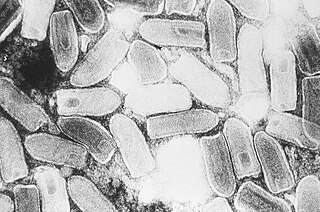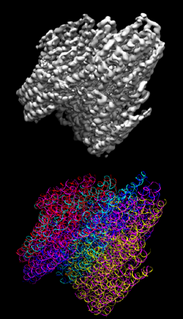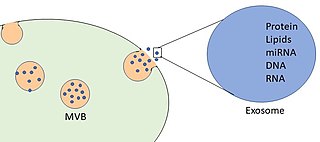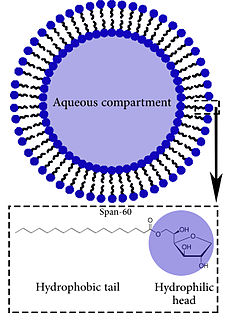Related Research Articles

Nanomedicine is the medical application of nanotechnology. Nanomedicine ranges from the medical applications of nanomaterials and biological devices, to nanoelectronic biosensors, and even possible future applications of molecular nanotechnology such as biological machines. Current problems for nanomedicine involve understanding the issues related to toxicity and environmental impact of nanoscale materials.

The lipid bilayer is a thin polar membrane made of two layers of lipid molecules. These membranes are flat sheets that form a continuous barrier around all cells. The cell membranes of almost all organisms and many viruses are made of a lipid bilayer, as are the nuclear membrane surrounding the cell nucleus, and other membranes surrounding sub-cellular structures. The lipid bilayer is the barrier that keeps ions, proteins and other molecules where they are needed and prevents them from diffusing into areas where they should not be. Lipid bilayers are ideally suited to this role, even though they are only a few nanometers in width, they are impermeable to most water-soluble (hydrophilic) molecules. Bilayers are particularly impermeable to ions, which allows cells to regulate salt concentrations and pH by transporting ions across their membranes using proteins called ion pumps.

Indiana vesiculovirus, formerly Vesicular stomatitis Indiana virus is a virus in the family Rhabdoviridae; the well-known Rabies lyssavirus belongs to the same family. VSIV can infect insects, cattle, horses and pigs. It has particular importance to farmers in certain regions of the world where it infects cattle. This is because its clinical presentation is identical to the very important foot and mouth disease virus.

A liposome is a spherical vesicle having at least one lipid bilayer. The liposome can be used as a vehicle for administration of nutrients and pharmaceutical drugs. Liposomes can be prepared by disrupting biological membranes.

Nanorobotics is an emerging technology field creating machines or robots whose components are at or near the scale of a nanometer. More specifically, nanorobotics refers to the nanotechnology engineering discipline of designing and building nanorobots, with devices ranging in size from 0.1–10 micrometres and constructed of nanoscale or molecular components. The terms nanobot, nanoid, nanite, nanomachine, or nanomite have also been used to describe such devices currently under research and development.
The vesicular monoamine transporter (VMAT) is a transport protein integrated into the membrane of synaptic vesicles of presynaptic neurons. It acts to transport monoamine neurotransmitters – such as dopamine, serotonin, norepinephrine, epinephrine, and histamine – into the vesicles, which release the neurotransmitters into synapses as chemical messages to postsynaptic neurons. VMATs utilize a proton gradient generated by V-ATPases in vesicle membranes to power monoamine import.

Anthracyclines is a class of drugs used in cancer chemotherapy that are extracted from Streptomyces bacterium. These compounds are used to treat many cancers, including leukemias, lymphomas, breast, stomach, uterine, ovarian, bladder cancer, and lung cancers. The first anthracycline discovered was daunorubicin, which is produced naturally by Streptomyces peucetius, a species of actinobacteria. Clinically the most important anthracyclines are doxorubicin, daunorubicin, epirubicin and idarubicin.

Nanofibers are fibers with diameters in the nanometer range. Nanofibers can be generated from different polymers and hence have different physical properties and application potentials. Examples of natural polymers include collagen, cellulose, silk fibroin, keratin, gelatin and polysaccharides such as chitosan and alginate. Examples of synthetic polymers include poly(lactic acid) (PLA), polycaprolactone (PCL), polyurethane (PU), poly(lactic-co-glycolic acid) (PLGA), poly(3-hydroxybutyrate-co-3-hydroxyvalerate) (PHBV), and poly(ethylene-co-vinylacetate) (PEVA). Polymer chains are connected via covalent bonds. The diameters of nanofibers depend on the type of polymer used and the method of production. All polymer nanofibers are unique for their large surface area-to-volume ratio, high porosity, appreciable mechanical strength, and flexibility in functionalization compared to their microfiber counterparts.

DNA origami is the nanoscale folding of DNA to create non-arbitrary two- and three-dimensional shapes at the nanoscale. The specificity of the interactions between complementary base pairs make DNA a useful construction material, through design of its base sequences. DNA is a well-understood material that is suitable for creating scaffolds that hold other molecules in place or to create structures all on its own.

The vesicular monoamine transporter 2 (VMAT2) also known as solute carrier family 18 member 2 (SLC18A2) is a protein that in humans is encoded by the SLC18A2 gene. VMAT2 is an integral membrane protein that transports monoamines—particularly neurotransmitters such as dopamine, norepinephrine, serotonin, and histamine—from cellular cytosol into synaptic vesicles. In nigrostriatal pathway and mesolimbic pathway dopamine-releasing neurons, VMAT2 function is also necessary for the vesicular release of the neurotransmitter GABA.

Vesicular monoamine transporter 1 (VMAT1) also known as chromaffin granule amine transporter (CGAT) or solute carrier family 18 member 1 (SLC18A1) is a protein that in humans is encoded by the SLC18A1 gene. VMAT1 is an integral membrane protein, which is embedded in synaptic vesicles and serves to transfer monoamines, such as norepinephrine, epinephrine, dopamine, and serotonin, between the cytosol and synaptic vesicles. SLC18A1 is an isoform of the vesicular monoamine transporter.
Neurotransmitter transporters are a class of membrane transport proteins that span the cellular membranes of neurons. Their primary function is to carry neurotransmitters across these membranes and to direct their further transport to specific intracellular locations. There are more than twenty types of neurotransmitter transporters.

Exosomes are membrane bound extracellular vesicles (EVs) that are produced in the endosomal compartment of most eukaryotic cells. The multivesicular body (MVB) is an endosome defined by intraluminal vesicles (ILVs) that bud inward into the endosomal lumen. If the MVB fuses with the cell surface, these ILVs are released as exosomes. In multicellular organisms, exosomes and other EVs are present in tissues and can also be found in biological fluids including blood, urine, and cerebrospinal fluid. They are also released in vitro by cultured cells into their growth medium. Since the size of exosomes is limited by that of the parent MVB, exosomes are generally thought to be smaller than most other EVs, from about 30 to 150 nanometres (nm) in diameter: around the same size as many lipoproteins but much smaller than cells. Compared with EVs in general, it is unclear whether exosomes have unique characteristics or functions or can be separated or distinguished effectively from other EVs. EVs including exosomes carry markers of cells of origin and have specialized functions in physiological processes, from coagulation and intercellular signalling to waste management. Consequently, there is a growing interest in clinical applications of EVs as biomarkers and therapies alike, prompting establishment of an International Society for Extracellular Vesicles (ISEV) and a scientific journal devoted to EVs, the Journal of Extracellular Vesicles.

Microvesicles are a type of extracellular vesicle (EV) that are released from the cell membrane. In multicellular organisms, microvesicles and other EVs are found both in tissues and in many types of body fluids. Delimited by a phospholipid bilayer, microvesicles can be as small as the smallest EVs or as large as 1000 nm. They are considered to be larger, on average, than intracellularly-generated EVs known as exosomes. Microvesicles play a role in intercellular communication and can transport molecules such as mRNA, miRNA, and proteins between cells.

Vesicular glutamate transporter 1 (VGLUT1) is a protein that in humans is encoded by the SLC17A7 gene.

A Niosome is a non-ionic surfactant-based Vesicle. Niosomes are formed mostly by non-ionic surfactant and cholesterol incorporation as an excipient. Other excipients can also be used. Niosomes have more penetrating capability than the previous preparations of emulsions. They are structurally similar to liposomes in having a bilayer, however, the materials used to prepare niosomes make them more stable. It can entrap both hydrophilic and lipophilic drugs, either in an aqueous layer or in a vesicular membrane made of lipid material.
Dendrosomes are novel vesicular, spherical, supramolecular entities wherein the dendrimer–nucleic acid complex is encapsulated within a lipophilic shell. They possess negligible hemolytic toxicity and higher transfection efficiency, and they are better tolerated in vivo than are dendrimers. The word " Dendrosome" came from the Greek word "Dendron" meaning tree and " some" means vesicles. Thus dendrosomes are vesicular structures composed of dendrimers.
A vesosome is a multi-compartmental structure of lipidic nature used to deliver drugs. They can be considered multivesicular vesicles (MVV) and are, therefore, liposome derived structures.
Magnetic nanoparticle-based drug delivery is a means in which magnetic particles such as iron oxide nanoparticles are a component of a delivery vehicle for magnetic drug delivery, due to their easiness and simplicity with magnet-guidance. Magnetic nanoparticles can impart imaging and controlled release capabilities to drug delivery materials such as micelles, liposomes, and polymers.
Tissue nanotransfection (TNT) is an electroporation-based technique capable of gene and drug cargo delivery or transfection at the nanoscale. Furthermore, TNT is a scaffold-less Tissue engineering (TE) technique that can be considered cell-only or tissue inducing depending on cellular or tissue level applications. The transfection method makes use of nanochannels to deliver cargo to tissues topically.
References
- ↑ Gupta, Ankit; Aggarwal, Geeta; Singla, Samita; Arora, Ritika (August 31, 2012). "Transfersomes: A Novel Vesicular Carrier for Enhanced Transdermal Delivery of Sertraline: Development, Characterization, and Performance Evaluation". Sci Pharm. 80 (4): 1061–1080. doi:10.3797/scipharm.1208-02. PMC 3528046 . PMID 23264950.
- ↑ Rai, Shubhra; Pandey, Vikas; Rai, Gopal (June 7, 2017). "Transfersomes as versatile and flexible nano-vesicular carriers in skin cancer therapy: the state of the art". Nano Rev Exp. 8 (1): 1325708. doi:10.1080/20022727.2017.1325708. PMC 6167026 . PMID 30410704.